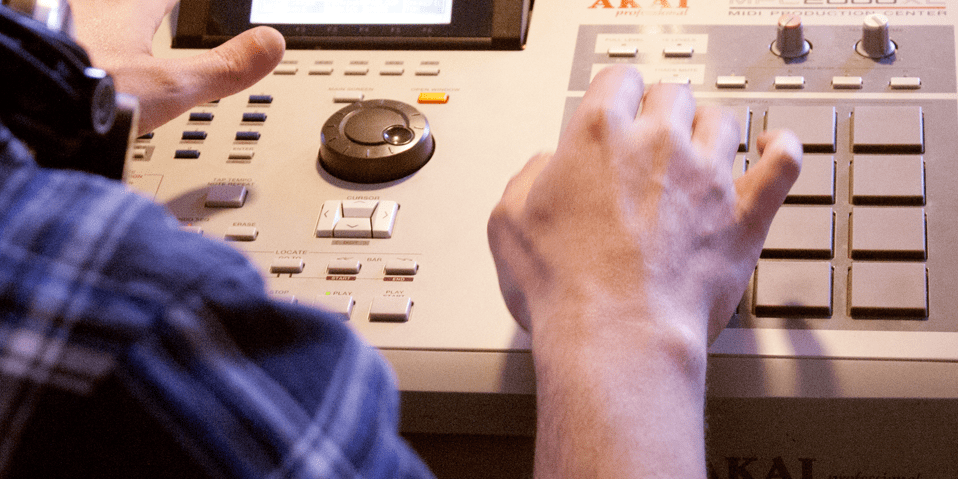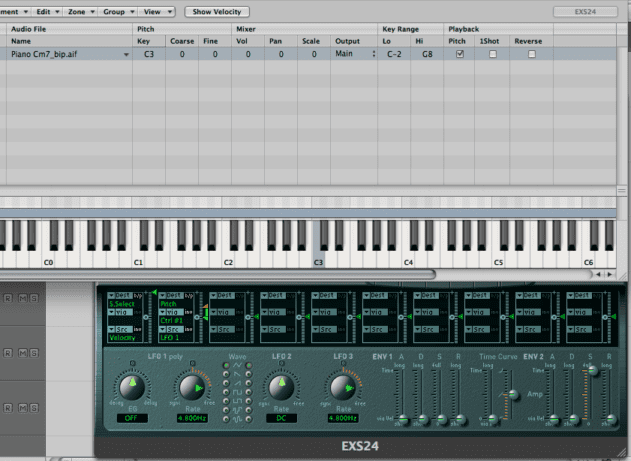How it’s done
To demonstrate this difference in timbre between sampled chords and notes sequenced manually, let’s create a simple example of our own. We’ll sample a C minor 7 chord played on a piano.
Here’s the original chord:

Having bounced the chord to audio, the resulting file is then imported into a sampler (you can achieve the same result in absolutely any sampler – in fact, the more basic, the better). As the root note of the chord is C3, we’ve set the key to ‘C3’, with the key range extended so that the chord can be pitched up and down from its original position:
The resulting difference in timbre can be heard as the chord gets pitched up and down:
The harmonics of the sampled piano keys change as the chord is pitched up and down, resulting in the unusual pitch-shifted timbre. Sampling technology in the 80s meant that this was originally quite a rough effect. If you can get your hands on a 12-bit sampler such as an Akai MPC60 or S900 or an E-mu SP1200, the lo-fi sound will be perfect for this technique. To exaggerate the effect using software, you could also try deliberately sampling the original chord an octave higher than you want to play it back, or using a bit-crushing plugin like D16’s excellent Decimort to add a bit of that vintage sampler feel to the sound.
To help understand how our sampled chord sounds in context, we can make a chord progression using just minor 7 chords. The first two bars in the piano roll below (the notes highlighted in red) show the progression sequenced using the same piano from which we took the initial sample. The second two (highlighted in green) show the notes used to play exactly the same chords, but this time using the sample.
Keeping In Scale
In some ways, using this technique can be seen as restrictive. Having only one chord shape available for our progressions creates a potential problem if we want to keep within a scale. However, if we’re prepared to play outside the scale, this technique can create chord progressions and melodies we’d perhaps otherwise overlook.
‘Feel It’ is relatively simple, only using minor 7 chords at the 1st and 4th degrees of the scale – Eb and Ab – both of which are chords comprising notes in the natural minor scale anyway. If we want to start using more chords, or to create a melody using our sampled chord, things can become a little more complicated.
For instance, below we have the C minor scale in triads (that is, using the notes from the C natural minor scale) – Cm, Ddim, Eb, Fm, Gm, Ab, Bb, Cm:
Everything sounds normal and within scale.
However, if we play each of the notes as a minor triad (i.e. we change those major and diminished chords to their minor equivalents), we can hear that the resulting sequence of chords has a much more unusual sound. Here’s the result – Cm, Dm, Ebm, Fm, Gm, Abm, Bbm, Cm:
Even though the root notes still conform to the natural minor scale, the often out of scale 3rds and 5ths of each triad chord give the progression an unusual sound.
Next, let’s take a listen to some further examples which demonstrate the potential of this technique for creating unique chord progressions and timbres…



09.27 PM
Another awesome article!! Thanks!
Just wanted to mention that I believe the Juno-60 was the first synth to introduce the chord memory feature. Although it is not specified in the user manual, one can play any chord with one finger over an octave, using some kind of “hack”.
07.44 PM
man i love this site!just gets better and better!
10.34 AM
Yes! Great article. It answers a lot of questions I always had and never figured out!
10.44 AM
Love the site and these tutorials!
11.38 AM
Quick question. If you sample a chord, why are you playing another chord with that sample.? Does that make sense?
11.54 AM
Ryan – we don’t quite understand what you mean. Do you mean in the Bicep example, why does the piano roll show chords being played? That’s just to demonstrate how the sampled chord progression would look.
12.07 PM
Yeh that is what I meant. So in actual fact you would just play the root key of that chord while the sample would be playing back a minor 7 I’m guessing? Thanks for clearing that up 🙂
12.10 PM
You got it. So in that example you’d sample the Ebm7 chord, set the original pitch in your sampler as Eb, then you’d play a C for Cm7, D for Dm7 and so on…
12.13 PM
Yep perfect! Thanks, just started to confuse myself for a moment there. Haha
01.20 PM
Great article! I will be trying this technique tonight!
06.08 PM
Awesome article! Attackmagazine is becoming a more and more important resource for me as a newcommer to production. =)
I’ve been playing around with this technique and getting some really interesting results. Thanks again and great work.
09.03 PM
I have learnt a shed load of stuff reading these articles.
Brilliant layout and examples.
Thank you very much.
04.02 PM
Hi,
Thanks for posting this article and for the whole site, what a revelation this is…
My question is simple –
If you run the technique of sampling a chord and then running it up/down the sampler – aren’t bound to be seriously off-key?
I mean a Major/minor scale has a limited amount of Major/Minor triad chords, not to talk about 7…
Thanks,
SkyLarking
04.32 PM
SkyLarking – yes, exactly right. As we mention on pages 2 and 3, it can be tricky to stick to conventional scales and keys with this technique, but that’s partly why it sounds so distinctive.
05.52 PM
Hi,
Sure…
So, any tips on running out of key but still playing it safe, or just do it by the ear and see what happens.
The latter method usually keeps away the more “musical” crowed, I believe…
Sky
12.38 AM
i just discoverd this site and i think this section is fuckin great! loving everything i read so far
04.03 PM
Hi – I also want to say that I find this site to be superb and the tutorials here are great. This is probably the best tutorial I have come across regarding this subject, but I am still left with a question that SkyLarking also poses.
I think resampled chords sound great and I’d love to use them more but I’m also worried about things like bass lines and melodies falling out of key with them. I understand basic music theory enough that it worries me.
Could you give us any tips on at least trying to stay in key with resampled chords, or is it literally just a question of using your ear?
03.31 PM
@ SkyLarking and ChelskiBoy
You both seem to be approaching this from the same angle, worrying about the ‘rules’ of music theory. That’s totally understandable. Those rules exist for a reason – they’re shortcuts to the accepted standards of what sounds ‘right’ based on centuries of western musical tradition. But, as with any discipline, music sometimes (but not always!) works best when you break a few rules. The Theo Parrish track is really a great example here – if you try to analyse that progression in theoretical terms you’ll probably determine that it’s a complete mess, but in context it works well.
However, we understand that the ‘if it sounds right it is right’ answer isn’t always satisfactory (and it’s used far too frequently as a cop out by journalists who are out of their depth or can’t be bothered to explain the subtleties of a subject).
However, this isn’t a black and white issue. You don’t just have to make a choice between staying in key or following your ear. You can do both. There’s a simple solution which allows much more control: sample more than one chord. For example, sample a minor chord and a major chord. That way you can get some of the pitched-up-and-down timbre and character of sampled chords while retaining more control over the scales your melodies and basslines can fit into without clashing.
04.56 PM
Great insightful read!
08.32 PM
Man, you’re really doing a good job here. I’ve been trying to tell people for ages that this was how ti was done, but nobody believed me. The house producers of the 80’s had limited studio gear, often no synth that had polyphony, but samplers were abundant. Great article, and the fact that you drive home the words with examples is even better.
12.04 PM
Thank you so much for those informations ! I use samples but never realized that it was the difference in speed that creates and add grain to that sound I love so much !
Keep up the good worl 😉
Cheers
08.57 AM
This stuff is not only accurate, but for those of us who already been doing it, it’s good motivation to hop back on that mpc! Great job